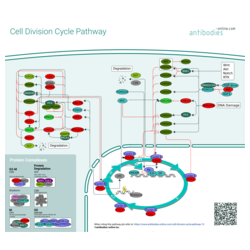Cycle Cellulaire
Tous les organismes (unicellulaires et pluricellulaires) reposent sur la réitération de la croissance et de la division des cellules existantes dans des conditions favorables. Au cours de chaque cycle de ce processus, la cellule passe par une série ordonnée d'événements au cours desquels son information génétique est dupliquée, puis divisée entre deux cellules filles. Ces événements sont étroitement régulés et certains points de contrôle doivent être franchis pour que le cycle cellulaire soit achevé. La perte de contrôle de ces processus est une caractéristique du cancer.
Le cycle cellulaire est divisé en quatre phases majeures basées sur les événements qui se déroulent dans la cellule. Au cours de la première phase lacunaire (G1), les protéines essentielles à la réplication de l'ADN sont produites. L'information génétique est alors répliquée pendant la phase de synthèse (S). Au cours de la deuxième phase d'interruption (G2), tous les composants nécessaires à la séparation de l'ADN dupliqué lors de la mitose suivante (phase M) sont produits. Les cellules qui ne se divisent pas activement sont considérées comme étant dans un état quiescent dans la phase de repos G0.
La division cellulaire est nécessaire à la vie, mais une division non régulée est dangereuse et contre-productive. Par conséquent, la cellule est incitée à maintenir un contrôle réglementaire étroit sur la façon et le moment où la division a lieu. Il existe deux points de contrôle majeurs dans le cycle cellulaire. Le premier point d'arrêt que la cellule doit franchir se situe entre les phases G1 et S. Une deuxième possibilité d'arrêt est offerte entre les phases G2 et M. Une fois que la réplication de l'ADN a été initiée, elle doit être terminée. Par conséquent, le principal point de contrôle du cycle cellulaire est le point de restriction (R) entre les phases G1 et S, avant la duplication de l'ADN, auquel le cycle progresse en fonction de facteurs mitogènes ou inhibiteurs tels que les dommages à l'ADN et les signaux provenant de diverses voies de signalisation.
La progression d'une phase à l'autre est contrôlée par les kinases dépendantes des cyclines (CDK) et leurs activateurs, les cyclines. Ces dernières sont instables et leur concentration cellulaire varie tout au long du cycle cellulaire. Par conséquent, les complexes cycline-CDK spécifiques persistent sous une forme active pendant une très courte période de temps après la traduction, puis sont dégradés ou inactivés au moment où cette phase particulière du cycle cellulaire se termine. L'activation de complexes cycline-CDK spécifiques est caractéristique des différentes phases du cycle cellulaire et entraîne la production de molécules spécifiques associées à cette phase de division et nécessaires à celle-ci. Des niveaux supplémentaires de contrôle dynamique sont également fournis par les inhibiteurs de CDK, qui bloquent la fonction CDK même en présence de leur cycline requise.
References
- : "Unraveling Cell-Cycle Dynamics in Cancer." dans: Cell systems, Vol. 2, Issue 1, pp. 8-10, (2018) (PubMed).
- : "Cell cycle development." dans: Developmental cell, Vol. 6, Issue 3, pp. 321-7, (2004) (PubMed).
- : "The cell cycle, cancer development and therapy." dans: Molecular biology reports, Vol. 49, Issue 11, pp. 10875-10883, (2022) (PubMed).
- : "Mammalian cell cycle cyclins." dans: Seminars in cell & developmental biology, Vol. 107, pp. 28-35, (2021) (PubMed).
- : "The cell division cycle and the pathophysiology of Alzheimer's disease." dans: Neuroscience, Vol. 87, Issue 4, pp. 731-9, (1998) (PubMed).





